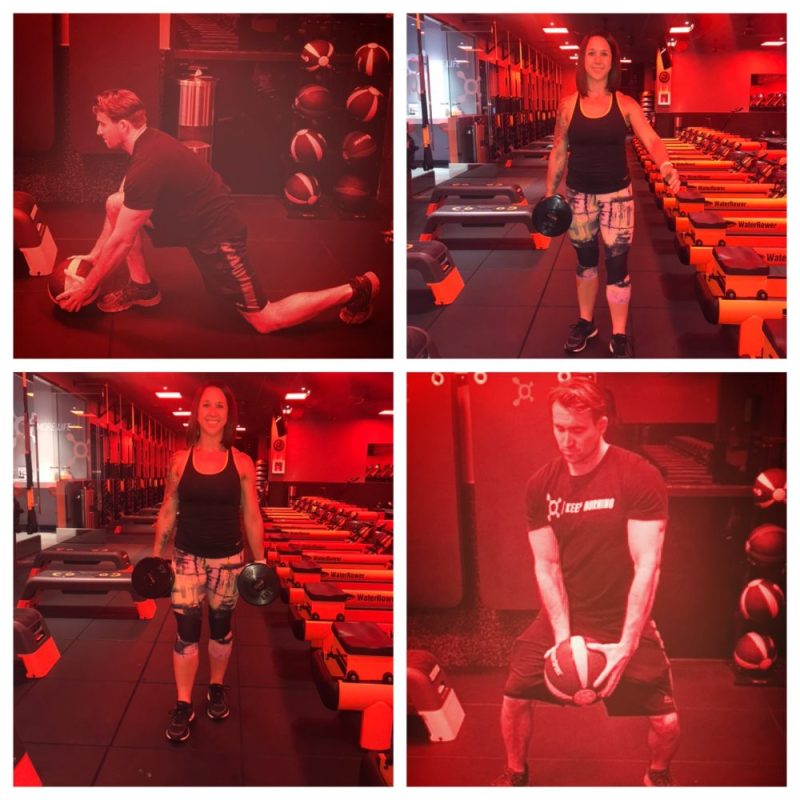
Incorporating standing core exercises in favor of sets of crunches and Russian twists will save time and better improve functional strength. So if you like tricking your clients as much as I do, I’ve got some sneaky exercises for you.
The “Love vs Hate” Core Connection
Clients often admit they don’t love “core work” saying that getting down on the floor and doing crunches is boring.
Honestly, I couldn’t agree more. I personally don’t do “traditional” floor core work. Instead, I like incorporating exercises that sneak in core work while targeting other muscle groups.
By training with other fitness pros, I’ve found my six favorite core exercises that wouldn’t typically strike people as “core” work.
6 Core Exercises Clients Can Do on Their Feet

Farmer’s Carry
Equipment: Two kettle or dumbbells of the same weight, heavier than grocery bags; think “functional” exercise.
Cues:
- Stand with a weight in each hand and a clear path ahead.
- Draw the navel into the spine to activate the core.
- Stack the shoulders over the hips, pack the shoulders down and back, and put one foot in front of the other.
- Walk purposefully with the weights, while stabilizing the core and joints.
Notes: These work well when added to a routine such as an AMRAP.
Suitcase Carry
Equipment: One kettle or dumbbell selected to be challenging, but not so heavy that the client will lean to one side controlling it, throwing the shoulders out of alignment or walking with one hip lagging behind.
Cues:
- Same as the exercise above, but weight is held in one hand only.
- Everyone has their own spin on what to do with their free arm. Some hold it out in front, while others tuck it tight to the side.
Bottoms up Kettlebell Carry
Equipment: Kettlebell. Since this one requires good grip strength, start with a weight light enough to be managed overhead with the working hand.
Cues:
- Similar to the suitcase carry, but the loaded arm is straight overhead, and the bottom of the kettlebell is up.
- Keep weight-bearing shoulder aligned and under the ear without elevating.
Kettlebell Rack-Position Standing Plank
Equipment: Two Kettlebells of the same weight
Cues:
- Hold kettlebells in the front rack-position (front squat position).
- Think of this as a standing plank: one straight line- ears over shoulders, over hips, over heals; pull the navel to the spine.
- Elbows stay bent to hold kettlebells at the chest.
- Don’t lean back.
- Once plank position is established, either hold in place or take small steps forward.
Medicine Ball Rainbow Slams with Lunge
Equipment: Medicine or Slam Ball
Cues:
- Start with feet in sumo squat position and hold a slam ball in front of the chest.
- Press the slam ball overhead and make an arc, like a rainbow, while pivoting the feet and body to the right to set up for a forward lunge.
- Slam the ball and lunge down at the same time.
- Grab the ball on the bounce back up, lunge up, and press the ball overhead as you pivot and repeat on the left.
Notes: Start slow to get the proper form and pick up pace when ready to advance. I always try to get clients to move in multiple planes of motion; this one is a staple because it works in both the frontal and transverse plane. It will leave them breathless!
Squat to Medicine Ball Woodchoppers
Equipment: Medicine Ball or Dumbbell (choose a weight that is not so light that it can be swung, yet just challenging enough to be pressed overhead)
Cues:
- Start in natural squat position with a medicine ball, or dumbbell, at chest.
- Lower the ball to the outside of the left shin by rotating the torso.
- When ascending from the squat position, pivot and rotate the torso to the right, and press the ball up over right shoulder. The shoulders, torso, hips, and knees should all be facing the same direction as the ball at the top of the chop.
What are your favorite core exercises in disguise?







